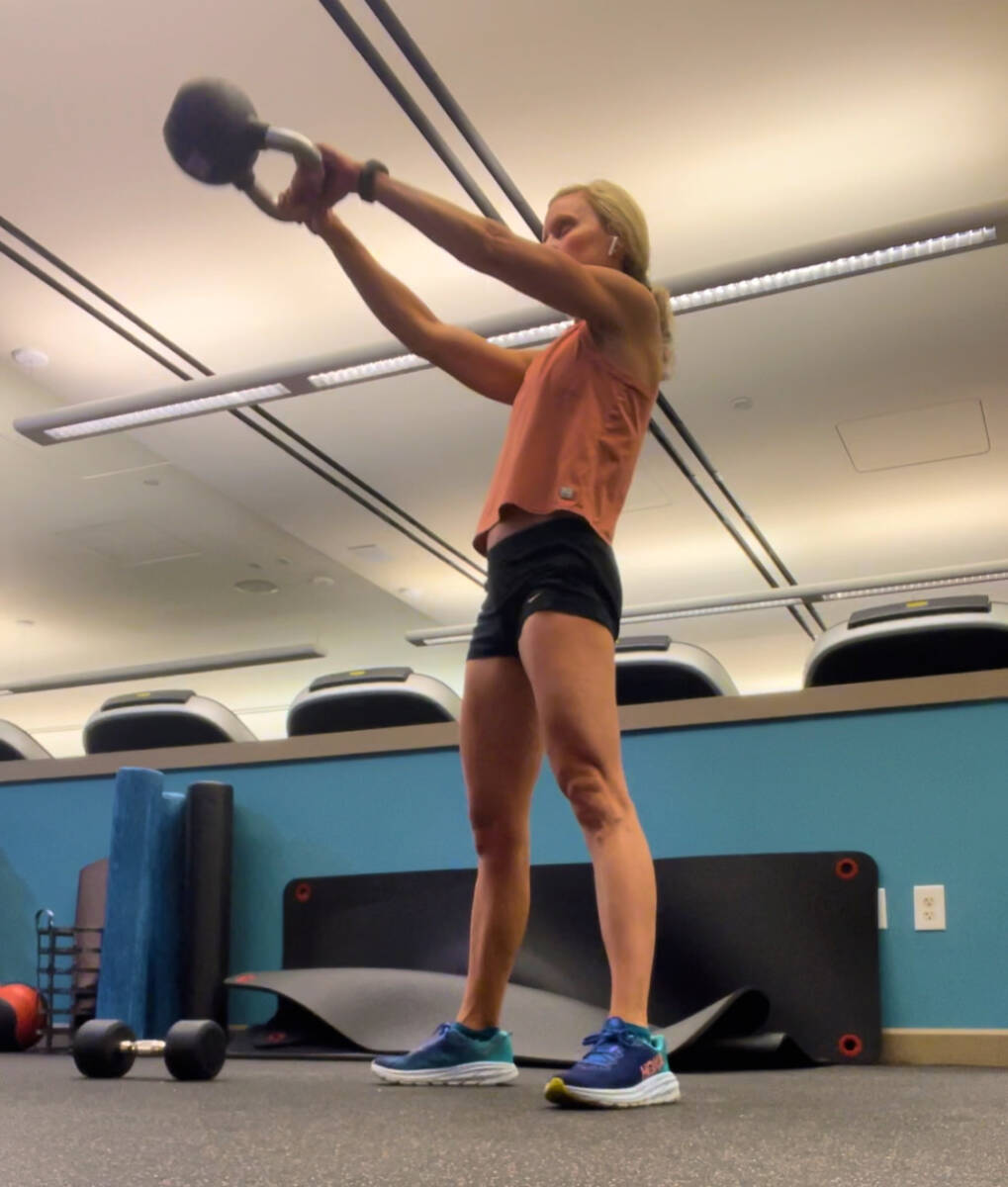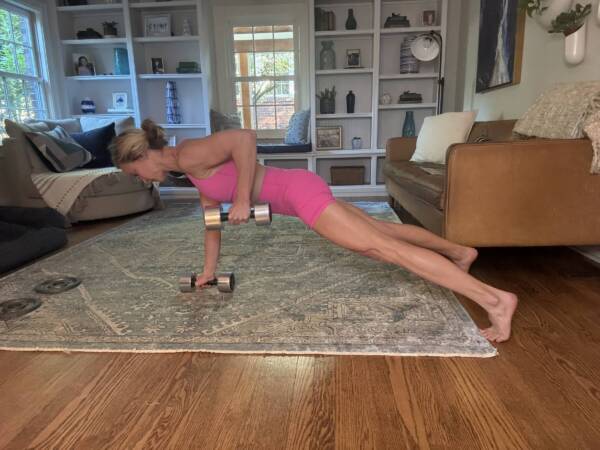Strength Training for Marathon Runners (Expert Tips + Moves)
Strength training for the marathon should balance out your marathon training program, says Mary Johnson, founder of Lift. Run. Perform. As your run training gets more intense, your lifting should get less intense. A strength training for marathon program should include heavy weights and lower reps, lighter weights with higher reps, isometric holds, eccentric moves, and plyometric jumps. Read on to learn what strength moves are best for the marathon and how to time your strength training.

Earlier this spring, I hit a wall. I was strength training for the marathon and felt really fatigued. I had been lifting after my track sessions, but I just felt so tired. It made sense. My running volume and intensity had really increased, yet I was still trying to lift the same volume and intensity as I was doing in the base phase. It just seemed like too much—and my body wasn’t having enough time to recover.
So, I listened to my body and my better judgment and scaled back on my strength training for the marathon. Then I talked with Mary Johnson, founder of Lift. Run. Perform., who explained how strength training should be periodized I knew it was the right call. Mary is a strength coach who specializes in strength training for marathon runners.
Skip Ahead
- Should runners lift weights?
- What are the different types of muscles?
- Do runners have fast twitch or slow twitch muscles?
- Is lifting for the marathon different than lifting for shorter distances?
- Lifting for the Marathon: A Strength Periodization Overview
- 7 Effective Strength Training Exercises for Marathon Runners
Study after study shows evidence that strength training is beneficial for runners. It can help runners have more endurance, power, and prevent injury.
Lifting for the Marathon: A Strength Periodization Overview
Like running, every BODY is different, so the needs of one person’s strength training for a marathon may be different than another. Below is a general overview of what weightlifting periodization for a marathon may look like to complement your running. Please note:
- The timescales are general. Some people may spend more or less time in each marathon training phase.
- Also, note that runners should be focusing on all types of strength training throughout the year. There is just an emphasis on some more than others throughout the marathon training cycle.
- Finally, again, this all depends on the person. For example, someone who has predominantly fast twitch muscle fibers will not see the same results from plyometrics as someone with mostly slow twitch muscle fibers.
Marathon Strength Training Phase 1 (Aerobic Base)
Weeks 1-4 (or 8+ weeks depending on runner’s background and goals)
Run training aim: During this training phase, marathoners are running mostly easy miles to build their base level of fitness. The focus during marathon base phase is building volume.
Strength training aim: Therefore, during the marathon base phase, runners will home in on building muscular strength. At this point in the training cycle, they do not need to worry about delayed onset muscle soreness (aka DOMS) impacting running workouts so it’s a great time to up the intensity in the weight room (or your house!).
Mary suggests runners who just finished a big goal race, take their training break, and then begin their hypertrophy phase (where microscopic tears from contraction allow our muscles to grow and get stronger) when they are running less.
This way they are building stress when the running demand is low, and they their bodies will have adapted to the new training stimulus by the time running intensity increases.
What it looks like: 3-4 days of lifting a week and 3-5 days of running a week
- Main focus is on lifting with rep schemes of 8, 12, and 15 reps (at what max percentage)?
- Do some days of heavier lifts of 3-5 rep schemes. (at what max percentage)?
- Perform strength training exercises that use both legs. (why both in base?)
- Also, sprinkle in plyometrics including A skips, B skips, pogo hops, jump squats, skater hops, and box jumps.
- Never neglect your core!
Marathon Strength Training Phase 2 (Aerobic Strength)
Weeks 5-9
Run training aim: During this phase of the marathon cycle, runners will begin to introduce faster running in the form of fartleks, progression runs, tempos, and steady states.
Strength training aim: As running intensity increases, runners can drop lifting to two strength days per week. They can lift heavy one day and lighter the other. It is best to lift after your running workout to concentrate stress and optimize rest.
What it looks like: 2 days of lifting a week, 4-7 days of running a week with 1-3 speed workout days
- Lift heavy with 3-5 rep schemes one day and lighter with 8-12 rep schemes on the other day.
- Begin performing single leg exercises. (why?)
- Continue to sprinkle in plyometrics and include core.
Marathon Strength Training Phase 3 (Peak)
Weeks 10-13
Run training aim: During the peak phase of training, runners will be doing more intense running workouts with VO2 max speed work, interval, and marathon pace workouts. Intensity and volume are both high during this training phase.
Strength training aim: Because the demands of running are high during the peak phase of the marathon cycle, strength training’s focus shifts to one of maintenance. Runners can lift weights on day a week and do mobility another day. If you are more advanced and can handle the training load, you can continue to lift twice a week on run workout day.
What it looks like: 1 day of weightlifting a week, 1 day of mobility, yoga, Pilates, or barre, 4-7 days of running a week with 1-3 speed workout days
- Lift heavy with 3-5 rep schemes one day or 8-12 rep schemes with lighter weights, and some plyometrics.
- If you are more advanced, you can continue to lift two times a week but do one less set, less reps, or incorporate isometric exercises where you hold the weight (using a lower weight) with less reps.
- Do mobility, yoga, Pilates, or barre on another day.
Marathon Strength Training Phase 4 (Taper)
Weeks 14-16
Run training aim: In the last 2-3 weeks before a marathon, marathon runners will begin tapering for the marathon. This means they will be running less to allow for their bodies to recover and be ready for race day.
Strength training aim: While runners will be running less during the marathon taper phase, this is not the time to increase strength training before a marathon. Runners should be lifting less weights in the weeks leading up to race day to allow for optimal recovery.
Lifting weights and running both create microtears in muscles. When the muscles heal, they build back stronger. However, we do not want to be breaking down during this phase. That has already been done. So, the aim for both running and lifting are to rebuild.
“At this point, runners want to keep themselves glued together and lifting can add injury at some point,” shares Mary.
What it looks like: Running progressively less volume each week. You will also be strength training
progressively less.
For most runners, in the few weeks leading up to the marathon, they should stop lifting and instead replace strength:
- Mobility
- Yoga
- Foam Rolling
- Core and upper body work
- Physical therapy exercises with bodyweight or bands
7 Effective Strength Training Exercises for Marathon Runners
Contrary to what you may see online or on Instagram, strength training for a marathon doesn’t involve complex moves. There are five basic movement patterns in strength training, Mary shares. These are:
- Squat
- Hinge
- Push/pull
- Carry
- Lunge
If you incorporate these movement patterns into your strength training exercises, you are covering your bases.
Front Goblet Squat
The front goblet squat helps strengthen the posterior chain and improve motion control.
How to do: With legs hip distance apart, hold a dumbbell, weight plate, or kettlebell in front of your chest with both hands. As you squat, elbow will go between your knees. Return to standing.
Russian Deadlift
RDLs help strengthen posterior chain and improve leg control.
How to do: Perform an RDL with both legs in the base phase of marathon training and with a single leg with
offset weight beyond base phase. With dumbbells or a bar, stand with feet hip-width apart. Hinge at hips with a straight back and lower weights close to your legs until you feel a stretch in the hamstrings. Return to start position.
Lunge
Lunges help leg stability and control.
Split Stance Power Lift Press
The split stance power lift press helps with anti-rotational movement by engaging core and moving the rest of your body.
How to do: Stand in a split stance holding dumbbells in each hand. Lift to chest with elbows bent beneath your chin. Then push up with force.
Suitcase Carry
Suitcase carries help with maintaining good posture while running.
How to do: Hold dumbbell, weight plate, or kettlebell in one hand like you are carrying a suitcase. Engage your core and walk 20 steps. Switch sides.
Push-up
Push-ups help with upper body and core strength and maintaining good posture.
How to do: get onto your hands and toes (or drop knees). Bend arms and lower chest to floor. Push-up. Add an eccentric hold halfway down by pausing for a few seconds to make harder. Increase difficulty by doing pull-ups using a pull-up bar.
Plank
Planks help strengthen core and improve running form and stability.
How to do: place hands and toes on the floor so that you are parallel to the ground. Hold for 60 seconds. Option to make harder by dropping to your elbows.
If you want guidance with your run training, including strength training, check out my run coaching services. Do you periodize your lifting for your marathon training?







“I found this essay is quite insightful and thought-provoking. The author did a great job of presenting strength training. However, I wonder if there are strength training routine for 16weeks marathon training that I could apply.
best regard
Chutiwat
Thanks for reading! I offer strength training with my coaching:).